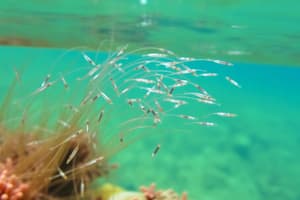Podcast
Questions and Answers
What are autotrophs?
What are autotrophs?
- Multicellular algae that lack vascular tissue
- Organisms that get energy from other living sources
- Organisms that are unable to swim against the current
- Organisms that get energy from sunlight or chemicals (correct)
What do heterotrophs depend on for energy?
What do heterotrophs depend on for energy?
- Other living sources (correct)
- Chemicals
- Sunlight
- Photosynthesis
What do producers need to survive in the ocean?
What do producers need to survive in the ocean?
Light, water, and carbon dioxide
The _______ zone is where sunlight rarely penetrates and is home to tuna.
The _______ zone is where sunlight rarely penetrates and is home to tuna.
What characterizes the dysphotic zone?
What characterizes the dysphotic zone?
What is the aphotic zone?
What is the aphotic zone?
What are plankton?
What are plankton?
Which organisms perform nearly all the photosynthesis in the ocean?
Which organisms perform nearly all the photosynthesis in the ocean?
What are dinoflagellates known for?
What are dinoflagellates known for?
What are coccolithophores composed of?
What are coccolithophores composed of?
Match the following words to their definitions:
Match the following words to their definitions:
How do seaweeds differ?
How do seaweeds differ?
Do plankton float?
Do plankton float?
What does a Reynolds number greater than 1 indicate?
What does a Reynolds number greater than 1 indicate?
Flashcards are hidden until you start studying
Study Notes
Primary Producers in the Ocean
- Autotrophs include plants, seaweed, and phytoplankton that harness energy from sunlight or chemicals.
- Heterotrophs, such as herbivores and carnivores, obtain energy by consuming other living organisms.
Light Zones in the Ocean
- For survival, producers require light, water (H2O), and carbon dioxide (CO2).
- The euphotic zone is the upper layer of the ocean where sunlight penetrates, supporting living species like tuna.
- The dysphotic zone, or twilight zone, experiences rapidly decreasing sunlight, prohibiting photosynthesis; inhabited by shrimp, swordfish, and hatchet fish.
- The aphotic zone is devoid of sunlight, where species such as squid and angler fish thrive.
Plankton
- Plankton are small organisms that cannot swim against ocean currents, classified into various types.
- Phytoplankton, including diatoms, dinoflagellates, and coccolithophores, are microscopic autotrophs accounting for nearly all ocean photosynthesis and producing about 50% of the Earth's oxygen.
Types of Phytoplankton
- Diatoms are unicellular algae with silica-based cell walls, enhancing light access to chloroplasts; reproduce asexually, bloom in large numbers, and are prominent in cold waters.
- Dinoflagellates feature two flagella for mobility, can cause harmful algal blooms (red tides) releasing toxins, and display bioluminescence, commonly found in warmer waters.
- Coccolithophores, single-celled photosynthetic organisms composed of calcium carbonate, bloom en masse, visible from space, and give a green milky color when abundant.
Seaweed Characteristics
- Seaweeds, multicellular algae, differ from plants by lacking vascular tissues and roots, and do not flower.
- They are autotrophs capable of photosynthesis, adapting in size and shape to ocean currents, and can be red, brown, or green.
- Key structures of seaweed include:
- Blades, the leaf-like portions.
- Holdfasts, which anchor the organism to the substrate.
- Pneumatocysts, gas-filled bladders assisting in flotation to reach sunlight.
- Stipes, providing structural support like a stem.
Additional Facts
- Seaweeds vary in color, primarily due to pigments in chloroplasts and materials in their cell walls.
- Plankton typically sink due to their density being greater than seawater, yet they should remain within the euphoric zone for optimal survival.
- The Reynolds number relates to an organism's fluid dynamics: values greater than 1 indicate higher inertia compared to viscosity, typically seen in larger organisms.
Studying That Suits You
Use AI to generate personalized quizzes and flashcards to suit your learning preferences.




